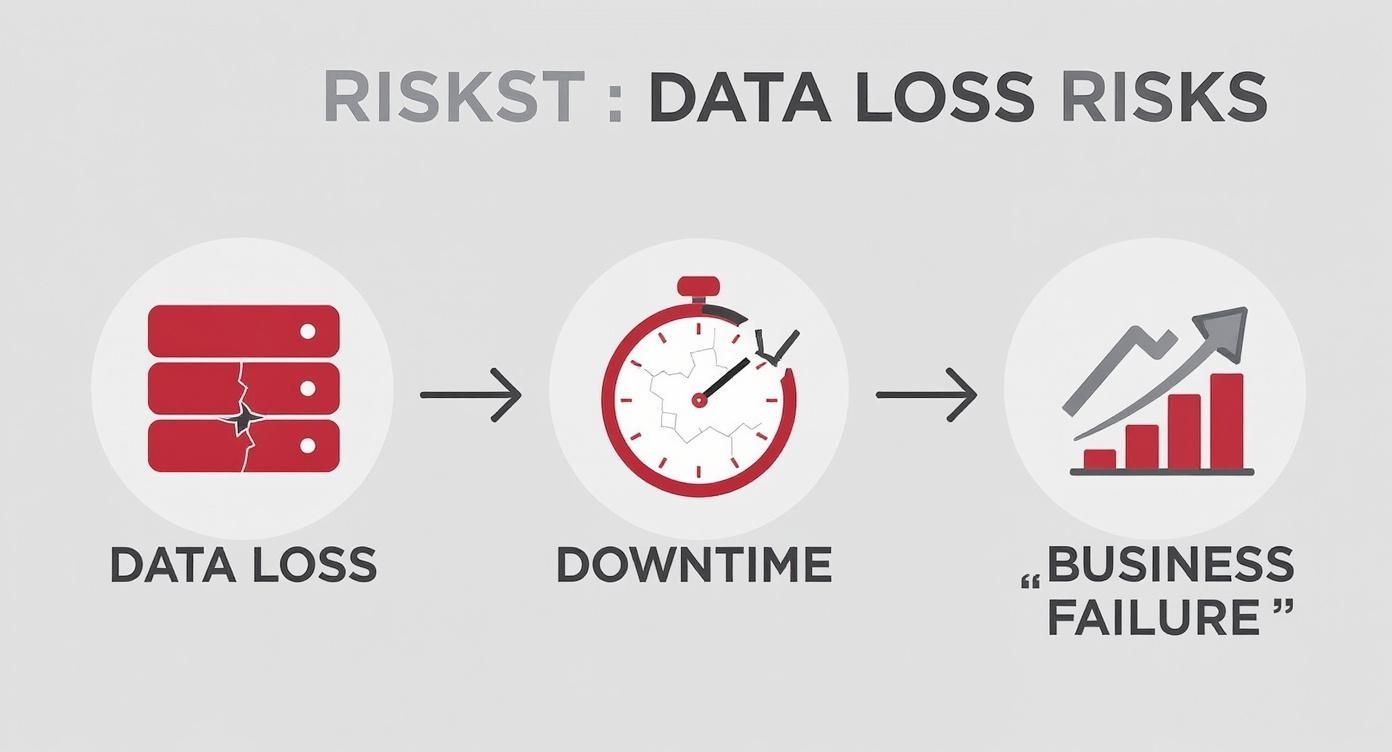Losing your company's data isn't just a headache; it's a full-blown crisis that can bring your business to its knees. We're not talking about a minor IT hiccup. For many, it's a knockout punch that dismantles years of hard work, sometimes in just a few hours.
The fallout from a significant data loss event goes far beyond a single crashed server or a successful phishing scam. It creates a domino effect that can paralyze every single part of your operation.
Why Data Loss Can End Your Business
When business owners think about catastrophic data loss, their minds often jump to sophisticated hackers in a dark room. The reality is usually much less dramatic, but no less damaging.
Think about the common culprits: an old server that finally fails, an employee accidentally deleting a critical folder, or a laptop with sensitive files getting stolen from a car. These everyday incidents are often the ones that snowball into a full-blown disaster, especially if you don't have the right safeguards in place.
The Real Price Tag of Lost Data
The immediate cost of downtime is just the tip of the iceberg. It's the hidden, lingering costs that truly cripple a company.
If you're in a regulated industry like healthcare or finance, a data breach can trigger massive fines. We're talking penalties in the hundreds of thousands, or even millions, of dollars. These aren't just slaps on the wrist; they're designed to be financially devastating.
Then you have to think about your reputation. You spend years building trust with your customers, but all that can be erased overnight. Once clients find out their personal information has been exposed, many will walk away and never come back.
It's a sobering statistic: a staggering 60% of small companies close their doors for good within six months of a major data loss event. This number makes it crystal clear that protecting your data isn't just an IT task—it's a fundamental strategy for survival.
When Your Operations Grind to a Halt
Beyond the fines and fleeing customers, data loss causes complete operational paralysis. Imagine your team without access to client records, financial data, or project files. What happens then?
Invoicing stops. Customer service tickets go unanswered. Your sales pipeline dries up. Every single minute your systems are down translates directly into lost revenue and wasted productivity.
This is why truly understanding the stakes is the first step. It's about shifting your mindset from reactive damage control to proactive, deliberate protection. This foundation is what allows you to build a resilient business that can withstand a crisis. Think of it this way: protecting your data isn't an expense, it's a non-negotiable investment in your company's future.
Building Your Data Backup and Recovery Plan
Your backup system is your last line of defense when disaster strikes. But simply having a backup isn't enough. That's a "set it and forget it" mentality, and it’s like owning a fire extinguisher you’ve never checked. When you really need it, will it work?
A resilient business needs a structured, multi-layered approach to not only backing up data but also recovering it swiftly when things go wrong. An untested backup is just a hope, not a strategy.
The Bedrock of Backup: The 3-2-1 Rule
The cornerstone of any solid plan is the 3-2-1 rule. It's a simple yet powerful framework that I’ve seen work time and again, ensuring data survives almost any imaginable scenario.
- Three Copies: Always maintain at least three copies of your critical data. This includes the original, "live" data you work with every day, plus two additional backups.
- Two Different Media Types: Don't put all your eggs in one basket. Store those backups on at least two different types of storage media. For instance, you might have one copy on a local network-attached storage (NAS) device and another on a cloud server.
- One Off-Site Copy: This is the most important part. Keep at least one of those backup copies in a physically separate location. This protects you from localized disasters like fires, floods, or theft that could wipe out everything in your office.
Choosing Your Backup Solution
With the 3-2-1 rule as your north star, the next big decision is where to store these copies. The choice between on-premise, cloud, or a hybrid model really boils down to your specific needs, budget, and how fast you need to get back up and running.
Here's a look at how the different backup solutions stack up. This table breaks down the pros and cons of each to help you figure out what makes the most sense for your business.
Comparing Backup Solutions
| Feature | On-Premise Backup | Cloud Backup | Hybrid Backup |
|---|---|---|---|
| Control | Full control over hardware and data. | Managed by a third-party provider. | A mix of both; control over local data. |
| Initial Cost | High (hardware, software, setup). | Low (subscription-based). | Moderate (local hardware + subscription). |
| Maintenance | Your responsibility. | Handled by the provider. | Shared responsibility. |
| Recovery Speed | Fast for local restores. | Slower, dependent on internet speed. | Fastest (local for speed, cloud for DR). |
| Scalability | Limited by hardware capacity. | Virtually unlimited. | Highly scalable. |
| Off-Site Storage | Requires a second physical location. | Built-in and automatic. | Built-in via the cloud component. |
Ultimately, the best solution is the one that aligns with your recovery goals and risk tolerance. A hybrid model, for example, is often a great choice because it offers both the speed of on-premise and the security of the cloud.
The infographic below really drives home just how quickly a single data loss event can spiral out of control, escalating from a minor hiccup to a complete business shutdown.

As you can see, a data loss incident is rarely an isolated problem. It’s a chain reaction that can have devastating consequences if you're not prepared.
Automating for Consistency
Let's be honest: human error is one of the biggest threats to any backup strategy. Manually running backups is a recipe for failure. People get busy, they forget, they make mistakes.
This is why automation is non-negotiable.
Modern backup software lets you schedule everything to run automatically—daily, hourly, or even continuously. This completely removes the human element from the equation, ensuring your data is always protected without anyone having to remember to click a button.
Defining Your Recovery Objectives
When a disaster hits, how quickly do you need to be back online? This isn't just a vague question; it's something you need to define with two specific metrics.
- Recovery Time Objective (RTO): This is the maximum amount of downtime your business can tolerate. If your RTO is four hours, it means you must have critical systems restored and operational within that timeframe.
- Recovery Point Objective (RPO): This defines the maximum amount of data you can afford to lose, measured in time. An RPO of one hour means your backups must be current enough that you would lose, at most, one hour's worth of data.
Setting realistic RTOs and RPOs is what guides your entire strategy. A company that needs near-instant recovery will invest in a very different solution than one that can stomach a full day of downtime.
The threat is real. Recent survey data shows that a staggering 67.7% of businesses worldwide reported significant data loss last year. In response, smart organizations are putting their money where it matters, with 26.7% investing in cloud security and 21.8% bolstering their backup systems.
If your business handles sensitive data, especially in healthcare, choosing a platform that meets strict legal standards is critical. Looking into a HIPAA-compliant cloud backup solution is a great starting point for ensuring you meet those regulatory requirements.
The Critical Importance of Testing
Finally, and this is the step I see businesses skip most often: you must test your backups. Regularly. An untested backup is just a theory, and it creates a dangerous false sense of security. The middle of a real crisis is the worst possible time to find out your recovery plan has a fatal flaw.
Schedule regular tests. This could be as simple as quarterly spot-checks where you restore a few random files. It should also include an annual full-scale drill where you simulate a major outage. Testing is the only way to prove that your plan actually works when you need it most.
Strengthening Your Cybersecurity Defenses
While a hard drive crash or an accidental "delete" can be bad, the threats that keep most business owners up at night are malicious attacks. Building a strong cybersecurity defense isn't just about installing some software and calling it a day. It’s about creating a layered shield around your data, where your technology and your people work together.

Of course, this starts with the basics like well-configured firewalls and endpoint protection. But the real work begins when you address the most common vulnerability in any organization: the human element.
Building Your Human Firewall
Let's be honest, technology alone can't stop a determined attacker, especially when a well-meaning employee can be tricked into handing over the keys. This is why focusing on your team is one of the single most effective things you can do to prevent data loss.
A staggering 68% of data breaches involve the 'human element' in some way. We're talking about unintentional mistakes or moments of deception that spiral into major incidents. A significant chunk of these—16%, to be exact—are phishing attacks, costing companies an average of $4.8 million per breach.
"Your employees can be either your weakest link or your greatest security asset. The difference comes down to training, clear policies, and a culture that prioritizes security."
Effective training isn't a boring annual slideshow. It has to be engaging, continuous education that empowers your team to spot threats and become a proactive line of defense.
Implementing Strong Password Policies
"Use a strong password." We've all heard it, but it's not enough anymore. Weak or reused passwords are a welcome mat for attackers. You need a clear, enforceable policy that makes good security hygiene easy for everyone.
- Enforce Complexity and Length: Passwords need to be a minimum of 12-14 characters. Require a mix of uppercase, lowercase, numbers, and symbols.
- Utilize a Password Manager: Seriously, this is a game-changer. Provide and encourage a company-wide password manager. This allows your team to generate and store unique, complex passwords for every single service without needing to memorize them.
- Discourage Password Reuse: Make it an explicit rule: do not use the same password for different systems. A breach on some random website shouldn't give an attacker a key to your company’s front door.
The Non-Negotiable Role of MFA
If you only implement one security measure this year, make it multi-factor authentication (MFA). MFA adds a crucial second layer of security, requiring something like a code from a mobile app or a text message in addition to the password.
Think of it this way: even if a thief steals your house key (the password), they still can't get in because of the deadbolt on the door (MFA). It's a simple step that blocks the overwhelming majority of account takeover attempts.
Not sure where to start? Prioritize rolling out MFA on these systems first:
- Email accounts (the gateway to everything)
- VPN and remote access portals
- Cloud applications holding sensitive data
- Financial and administrative software
Smart Access Control and Patching
Not every employee needs access to every file. This simple idea is the heart of the principle of least privilege—a cornerstone of good security. It means you only grant employees access to the specific data and systems they absolutely need to do their jobs.
This simple practice dramatically minimizes your risk. If an employee's account is compromised, the blast radius is contained. The attacker only gets access to a small slice of your data, not the whole pie. Make a habit of reviewing user permissions, especially when people change roles or leave the company.
Finally, keep your software updated. Consistent security patching is your defense against known vulnerabilities. Many of the most damaging cyberattacks in history didn't rely on some brilliant new hacking technique; they simply exploited old, unpatched flaws that companies knew about. Automate patching wherever you can, and have a clear process for applying updates to servers, workstations, and network devices. To dive deeper into securing your network, check out our guide on network security best practices for more actionable tips.
Using Modern Data Loss Prevention Tools
Solid backups and cybersecurity basics are your foundation, but what happens when the threat is internal? This is where dedicated Data Loss Prevention (DLP) tools come in. Think of DLP less like a castle wall and more like an intelligent security team that knows exactly what your critical data is and where it's allowed to go.
These systems are designed to stop data exfiltration—the unauthorized transfer of data—before it’s too late. They’re constantly watching your network, employee endpoints, and cloud services to block any sketchy attempts to move sensitive information.
How Data Loss Prevention Actually Works
At its core, DLP technology follows a simple but powerful mantra: identify, monitor, and protect. It all starts with teaching the system what information is most valuable to your business.
First, you define what "sensitive data" means for you. Is it your customer list? Financial records? Proprietary source code? Once you’ve set the rules, modern DLP solutions get to work using smart techniques like pattern matching and keyword analysis to automatically discover this information, no matter where it’s hiding.
With everything identified, the DLP system starts enforcing the policies you've created. These are the rules of the road for your data.
- An employee drags a client database to their personal Dropbox folder? Blocked.
- Someone tries to copy-paste a folder of financial projections into a Gmail message? Blocked.
- A user attempts to upload a document with intellectual property to an unsanctioned web app? Blocked.
This proactive stance is what separates DLP from other security measures. It shifts your posture from simply reacting to threats to actively controlling the flow of your most valuable digital assets.
Why Cloud DLP Is No Longer Optional
The old concept of a secure "network perimeter" is a thing of the past. Your data isn't just sitting on a server in your office anymore. It's on laptops at home, on phones in coffee shops, and spread across countless cloud applications. This is precisely why cloud-based DLP has become non-negotiable.
Cloud DLP extends that same intelligent protection to the services you use every day, like Microsoft 365, Google Workspace, and Salesforce. It ensures your security policies follow your data, keeping it safe whether your team is in the office or working from the other side of the world.
The explosive growth in the DLP market tells you everything you need to know about its importance. Valued at $35.38 billion, the global DLP market is projected to skyrocket to $94.09 billion by 2030. A huge piece of this is the move to the cloud, with cloud solutions already making up 67.3% of the market. You can explore these data loss prevention market trends to see where the industry is heading.
Choosing the Right DLP Solution
Not all DLP tools are built the same, and the best one for you hinges entirely on your business, industry, and the specific risks you face. As you start looking at options, keep these key factors in mind to make sure you’re putting your money in the right place.
Key Considerations for a DLP Tool
| Feature | What to Look For | Why It Matters |
|---|---|---|
| Data Classification | Automated and custom classification capabilities. | You can't manually tag thousands of files. The tool needs to find sensitive data for you. |
| Endpoint Protection | Coverage for Windows, macOS, and even Linux systems. | Your policies are useless if they don't work on every device your team uses. |
| Cloud Coverage | Direct integrations with the specific cloud apps you use. | If your DLP doesn't plug into your main SaaS tools, you have a massive, unmonitored blind spot. |
| Policy Enforcement | Granular controls to block, alert, or encrypt data. | You need the flexibility to create rules that fit your workflows, not bring them to a halt. |
| Reporting & Alerts | Real-time alerts and detailed incident reports. | When a policy is violated, you need to know immediately so you can understand the risk and respond. |
Putting a DLP solution in place is a massive step toward building a truly resilient security posture. It's the technology that turns your written security policies into active, automated protection, giving you the power to safeguard the information that keeps your business running.
Creating Your Disaster Recovery Playbook
Hoping for the best isn't a strategy. After you’ve fortified your defenses, you need a concrete plan for what to do when something inevitably breaks through. A Disaster Recovery Plan (DRP) is the playbook your business will follow when a data catastrophe strikes, guiding you through the chaos.
This isn't a document you create once, file away, and forget about. It's a living guide to business survival that ensures everyone knows exactly what to do when the pressure is on. Without it, you're just improvising during a crisis—and that almost never ends well.

A well-crafted DRP transforms panic into a methodical response, dramatically reducing downtime and financial bleeding. It’s what separates a temporary setback from a business-ending event.
Assembling Your Response Team
When a disaster hits, ambiguity is your worst enemy. The very first move is to clearly define who is on the disaster recovery team and what their specific roles are. There can't be any confusion about who has the authority to make the tough calls.
And this team isn't just your IT department. It needs key players from across the company.
- IT Lead: The technical commander who oversees system restoration from backups and manages all vendor communications.
- Operations Manager: The logistical expert who coordinates manual workarounds with different departments to keep the business running as smoothly as possible.
- Communications Head: The voice of the company, responsible for all internal and external messaging to employees, clients, and the public.
- Executive Leadership: Provides the final sign-off on major decisions and manages the high-level business impact.
Everyone on this list needs a designated backup in case they’re unavailable. This clarity is what creates a swift, organized response instead of a chaotic free-for-all.
Establishing Clear Communication Channels
During a crisis, your normal communication methods might be toast. What happens if your email server is offline or your VoIP phone system is completely inaccessible? Your DRP must outline alternative communication channels.
This could be a dedicated group chat on a third-party app like Signal or even a simple phone tree. More importantly, the plan should contain a master contact list with personal phone numbers and email addresses for all essential personnel.
Your communication plan has to extend beyond your internal team. You need pre-drafted templates for notifying clients about service disruptions. Being transparent and proactive builds trust, even when things are going wrong.
Prioritizing System Restoration
You can't bring everything back online at once. A solid DRP includes a tiered recovery strategy that prioritizes systems based on their direct impact on core business functions. The goal is to slash operational downtime and get revenue-generating activities back up and running first.
A typical priority list might look something like this:
- Tier 1 (Critical): Core financial systems, the primary customer database, and your e-commerce platform. These must be restored within your defined RTO (e.g., 4 hours).
- Tier 2 (Essential): Email servers, internal project management tools, and client support systems.
- Tier 3 (Non-Essential): Development servers, marketing analytics tools, and other systems that can wait a day or two.
This tiered approach focuses your recovery efforts where they matter most. It prevents your team from wasting precious time on low-priority systems while the heart of your business remains paralyzed. Some events, like malware, demand their own specialized playbook; learning how to recover from a ransomware attack will help you prepare for that specific nightmare scenario.
Testing and Refining Your Playbook
An untested plan is just a piece of paper. The only way to know if your DRP will actually hold up under pressure is to test it regularly. Running drills and tabletop exercises isn’t optional—it’s an essential part of the process.
During a tabletop exercise, you gather your response team and walk through a simulated disaster step-by-step. I've seen these simple practices uncover all kinds of gaps, from outdated contact lists to flawed technical assumptions. These tests find the weak spots before a real disaster does, allowing you to refine your playbook into a battle-hardened strategy.
Weaving Security Into Your Company's DNA
We’ve covered a lot of ground, from building a bulletproof backup strategy and beefing up your cybersecurity to using smart DLP tools and mapping out a disaster recovery plan. Think of these not as separate tasks to tick off a list, but as interconnected layers of protection for your business's most valuable asset: its data.
Protecting your data isn't a "set it and forget it" project. It's an ongoing commitment, a fundamental part of how you should operate every single day. The pieces we've discussed are powerful on their own, but when they work in concert, they create a truly resilient defense.
Don't Get Complacent: The Threat Is Always Changing
Here’s the hard truth: the security strategy that was rock-solid last year might be full of holes today. Cyber threats are constantly evolving. New vulnerabilities pop up, and attackers get more creative with their methods every day. Staying ahead requires a proactive mindset, not a reactive one.
This means you need to be constantly on your toes, re-evaluating your risks and fine-tuning your defenses.
- Are you auditing user access permissions regularly? Who really needs access to that sensitive folder?
- Do your employees know what the latest phishing scams look like?
- When was the last time you checked for and applied critical software updates? Don't delay those patches.
The real game-changer in preventing data loss is creating a security-first culture. When every single person on your team understands their role in protecting data, they shift from being a potential vulnerability to becoming your greatest security strength. That collective awareness is what stops both accidents and attacks in their tracks.
Use the strategies in this guide as your blueprint. They're designed to help you not just survive a potential data disaster, but to build a more secure, resilient, and trustworthy business for the long haul. The end goal is simple: make data protection so ingrained in your operations that it becomes second nature.
Answering Common Questions About Data Loss Prevention
When you start digging into how to prevent data loss, a lot of questions pop up. It's completely normal. Getting solid answers is the first step to building a plan you can actually rely on to protect your business.
Let’s go through some of the most common questions I hear from business owners who are getting serious about protecting their data.
What Is the Biggest Data Loss Risk for Small Businesses?
It's easy to get caught up in news about sophisticated cyberattacks, but the reality for most small businesses is much more mundane. The biggest culprits are often right under your own roof: human error and hardware failure.
I’ve seen it happen countless times. An employee accidentally deletes a crucial folder that everyone uses, or a server that’s been humming along for years suddenly dies. These everyday scenarios are far more common than a dramatic, targeted hack. This is exactly why automated backups and clear internal procedures are so critical—they protect you from the most likely threats, not just the most sensational ones.
An untested backup isn't a strategy; it's just a hope. You can only be confident in your ability to recover if you regularly prove the process works from start to finish.
How Often Should We Test Our Backups?
Having a backup is a great start, but knowing for sure that you can restore from it is what really matters. You absolutely need a consistent testing schedule. From my experience, a two-part approach works best because it’s thorough without being overwhelming.
- Quarterly Spot-Checks: At least once every quarter, pick a few files or a small dataset to restore. The goal is to make sure the data is not only there but also usable and free of corruption.
- Annual Full-Scale Drills: Once a year, you should run a full disaster recovery simulation. Think of it as a fire drill for your data. This "tabletop exercise" gets your entire response team to walk through a major outage scenario, testing everything from your communication plan to your process for bringing critical systems back online.
Is Using the Cloud Enough to Protect My Data?
The short answer is no. Just moving your files to a cloud service like Microsoft 365 or Google Drive is not a complete data protection strategy on its own. While these services provide fantastic uptime and protect against hardware issues on their end, they're only one part of the equation.
Cloud storage won't, by itself, save you from ransomware that encrypts all your synced files, or from an employee who accidentally deletes a massive amount of data. It also can’t stop a malicious actor who gains access to a compromised account. A real data protection plan uses the cloud as a component, but it also includes dedicated backup solutions, strong cybersecurity defenses, and a disaster recovery plan that you’ve actually practiced.
Keep your business running without IT headaches.
GT Computing provides fast, reliable support for both residential and business clients. Whether you need network setup, data recovery, or managed IT services, we help you stay secure and productive.
Contact us today for a free consultation.
Call 203-804-3053 or email Dave@gtcomputing.com



